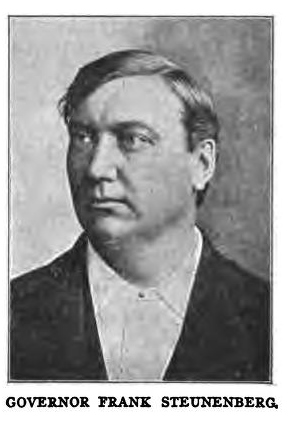Assassination of Governor Steunenberg
Abstracted from "History of the State of Idaho," by Cornelis J. Brownan, published by Charles Scribner's Sons, 1918; p. 195.

Assassination of Governor Steunenberg (l905). – Six years afterward1, when Governor Steunenberg was entering his home at Caldwell, on the evening of December 3o, 1905, a bomb which had been fastened to his gate was exploded and caused his death. Harry Orchard was arrested for this crime and confessed that he had placed the bomb which killed the former governor. His confession also implicated Charles H. Moyer, the president of the Western Federation of Miners, William D. Haywood, secretary and treasurer, and George A. Pettibone, a member of the executive committee, under instructions from all of whom Orchard claimed he had been acting. Orchard also freely confessed that he had committed a number of other serious crimes. Haywood, and Pettibone were separately tried for the murder (May, 1907, to January, 1908). At these trials, Orchard acted as chief witness for the State. Both trials, however, resulted in the acquittal of the defendants and soon afterward the State dropped the prosecution against Moyer. Later, Orchard himself entered a plea of guilty to the charge of murder and was sentenced to be hanged, but this sentence was afterward changed to life imprisonment and he is still confined in the penitentiary.
The assassination of Governor Steunenberg sent a wave of grief and indignation over the entire State. The confession of Orchard and the trials of Haywood and Pettibone attracted the attention of the nation, and newspaper men from all parts of the country attended and reported the trials.
previously -
1 Industrial Disturbances (1892 and 1899). – Idaho, like other mining States, has had her share of industrial troubles. The first outbreak occurred in the Coeur d'Alene mining district, in 1892. Trouble over wages led to a strike. New men were brought in. This gave rise to acts of violence. A mill was blown up and federal troops had to be called in to restore order. From then until 1899 there were various acts of lawlessness in the Coeur d'Alene district. Men were killed on little or no provocation and the towns were terrorized. The climax came in the destruction of the Bunker Hill and Sullivan Mill by dynamite, in 1899. Governor Steunenberg was forced to call for federal troops. Several hundred miners were arrested and confined for a time in a stockade which at one time had been used for cattle. The prisoners called this the "bull pen." Paul Corcoran, a leader, was tried and sentenced to prison for a term of years. Order was finally restored, but feeling ran high and many threats were uttered against the governor.
Note:
Much has been written about the Steunenberg assassination and the preceding events.
See J. Anthony Lukas. Big Trouble. Simon & Schuster, New York, 1997;
David H. Grover. Debaters and Dynamiters/The story of the Haywood Trial, Caxton Press;
Idaho Meanderings: Steunenberg, Trial of the Century, Labor, Legal, Political History

Webspace for this site is generously provided by Genealogy Village and Access Genealogy
Copyright © 2013 - Sharon McConnel. All Rights Reserved.
